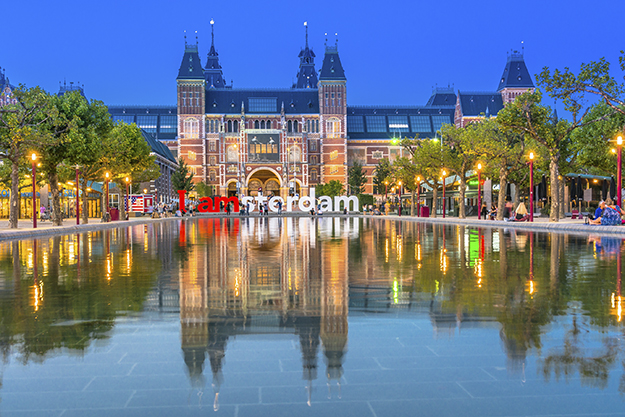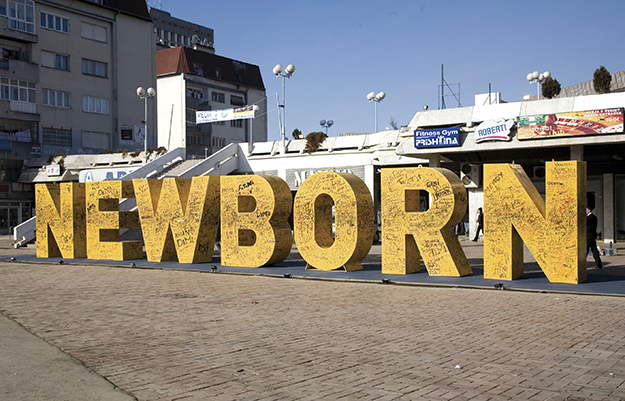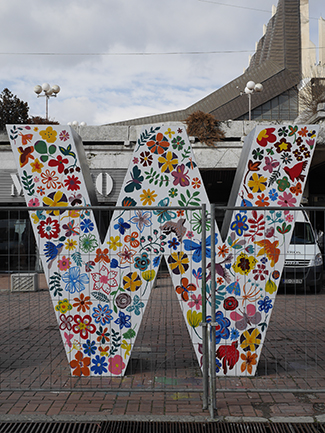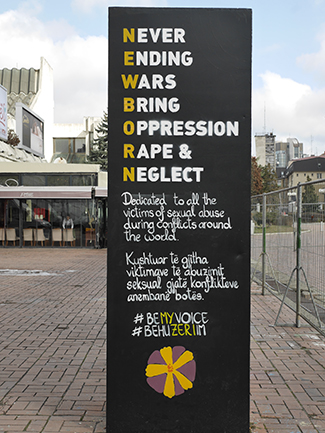There’s something strange in the evolution of the “Newborn” monument and, in my opinion, it’s suspect. Since independence the “Newborn” monument has served as a visual and symbolic icon of the new state of Kosovo.
The sculpture, as a design, and as an artwork, functions symbolically and smartly for both domestic and international audiences. As a graphic, the form is designed within a universally neutral Modernism. The letterforms are styled from the FF DIN typeface, a derivative of the famed Helvetica font, the now globally employed letter-type of all things industrial, clear, universal, sterile and safe and — as a formal object — therefore devoid of any ethnic, national or subjective flavorings.
It’s a typeface that was designed to be international and universal, without allegiance to ethnicity, politics or decadence. At the same instant, it’s a declaration, “Newborn,” as a communication, an English word that defies it’s antonym, “Stillborn” (to be delivered dead), and promises new life, changed life, emergence, another chance.
“Newborn,” as a monument, is a triumphant exclamation that allows for this exploration of a new life and offers an associated reflection to the power of redemption. Not so much that you feel its pride, and not so obvious in the common sentiment as stated here in analysis, but as an image, in language and in form.
This is a well thought out choice for the aspirations of a geographically small and economically depressed emergent nation of the former Yugoslavia; in the crossroads of the Balkans, looking then as now to establish new bonds with strong allies in America, in Europe, and around the world.

Artist Robert Indiana is credited with popularizing the idea of a graphic word sculpture. Photo courtesy of Daniel Cosentino.
When viewed as an artwork, a letter-form sculpture manufactured from core-ten steel, it has a reminiscence to other inspiring artists and forms from marketing campaigns to Pop Art. For example, the globally recognized and admired “LOVE” sculpture by Robert Indiana that led ultimately, in its time, to a genre form repeated and appropriated by artists around the world.
Even if indirect in association, the concept serves a positive connection to collective ideals, and not, as would be feared, to an ethnic or nationalist sentiment tied in form, material or construction to an ancient or dead aesthetic.
As a marketing plan it’s reminiscent of the successful 2004 Dutch tourism campaign “I Amsterdam” (“I am Amsterdam”), from which the creator Fisnik Ismaili, no doubt drew influence when “Newborn” was manufactured for Kosovo’s Day of Declaration of Independence from Serbia in 2008.
A good artist/designer is aware of these aesthetic histories and trends and appropriates them to merge with the collective pulse of the historic times. Kosovo needed a catchphrase that projected a formal, hopeful, and alluring message, it got that with “Newborn.”
Kosovo also needed new symbols and monuments to be used as a marketing tool, a place of gatherings (and selfies), a tourist destination for domestic and foreign visitors that wasn’t focused on war heroes (or anti-heroes) or the tragedies of war. As a creative choice, these positive and successful associations in concept and form have served its purpose well given Kosovo’s remote and distant locale away from the international political stage.

A clear inspiration to the “Newborn” monument is this sculpture from the 2004 Dutch Tourism campaign. Photo courtesy of Daniel Cosentino.
As a National Monument, “Newborn” is unique among the symbols arising in post Yugoslavian identities. A national monument by definition is a preserved place or object that commemorates a historic person or event and is owned and maintained in the public interest for current and future generations to enjoy and study.
When a monument is a sculpture it often takes the form of military men, politicians, or nationals who have made significant contributions to the formation of the state or more broadly to regional or world culture. The fact that these persons commemorated are nearly always men (and not women) can stand, in a contemporary context, as intrusive symbols ignorant to the social progress made toward gender equality and representative justice, even if unintentional.
In summary, the word, the symbol, the design and the artwork, is created and functions with good timing and meaningful national symbolic significance for the emergent Republic of Kosovo and its people.
As an example, a quick glance south east to Skopje (about 90 km) and we find the famously problematic behemoth of a fountain/sculpture in the equestrian mounted Alexander the Great constructed in a faux baroque style. Now infamously notable to colleagues in the arts and humanities (and to much of the public) as unintended kitsch and decidedly not of a modern national character.
To place “Newborn” as a universally recognizable symbol within contemporary creative and marketing references and mark it as a National Monument, is to inspire and guide the collective political and social aspirations of a state. It does so without succumbing to the sentimental romantic nature of aligning to an historically distant aesthetic and the accompanying ideology to that aesthetic. “Newborn” is a smart choice, a good design, and serves as an alluring artwork.
The locus of our thoughts have ample opportunity to reminisce in the real surroundings of such a well-timed and placed statement on the ground at a historic moment, the day of Independence. The work remains conceptually free of the historic battles for relevance that nearby monuments, both domestic and international, inhabit, providing a truly neutral concept for the public to visit, enjoy, preserve, and study.
“Newborn” establishes itself, outside of its former bounds, the former Yugoslavia, to that of decidedly Western ideals, even as the locality remains engulfed in the realities of its histories. In summary, the word, the symbol, the design and the artwork, is created and functions with good timing and meaningful national symbolic significance for the emergent Republic of Kosovo and its people.
A new paint job — sculpture as performance
Even still, the creative force behind such a statement did not end there. On Independence day and in subsequent years people came to the sculpture to write their names, a sign of personal connection and sincere affinity for what this monument declares and the symbolic representation it embodies.
The original yellow/gold faded under the marks of so many names so that after a lag of time, some five years, the sculpture, now a state protected monument, was looking unkempt and lacked upkeep and fresh perspective.
Ismaili, as reported in Alex Marshall’s 2018 NY Times piece, struggled with the impulse to make changes to the sculpture but ultimately decided to act anyway, without state permission, to give it new life. It did not return to the former colors but instead took on new colors, symbols and representations, as a kind of performance work.

The “Newborn” monument was the designer Fisnik Ismaili’s idea to celebrate Kosovo’s independence. Photo courtesy of Daniel Cosentino.
After that initial hiatus of five years since the “Newborn” monument was unveiled, the veneer of the sculpture is repainted or altered and unveiled on Independence day each year to reveal a social/political message that reflects, in part, the domestic concerns of Kosovo’s people. However, it is ultimately decided upon by Ismaili, a former politician himself.
If the conceptual and physical construction was indeed centered in foreign associations to culture and capital matching Kosovo’s ambitions as a new kind of place ready to enter the world stage, it’s veneer now belonged uniquely to domestic concerns and transformed it into a performance stage for the artist.
Ismaili, like many people of similar fame in the newly independent Kosovo, began increasing his direct involvement into politics and populist activism. This literal reflection of the struggles and sentiments of the people gave the Newborn an updated dynamic postmodern aesthetic.
This update served as a bold evolution from the stolid, successful, already established form. As an artwork, this new performative element provided a good balance of outward projection and inward reflection to the social and political state of affairs in Kosovo. For several years this change was dynamic and meaningful, both as an alluring work of art and as a marketing tool. That is, until two years ago — it’s what happened from here that I call “suspect.”
The re-appropriation
The yearly changes to the “Newborn” Monument, orchestrated by Ismaili, have taken a form as a series of social/political commentaries that reflect the sentiments of the young, progressive, activist community. This served as both a reminder of the current political circumstances and as a resistance to the failures and disappointments endured under the leading political parties since independence. The forms became trend and the trend became a locus of discussion while the monument retained its formal structure and reminiscent associations described above.
This new form behaves more now as contemporary postmodern artwork, alive to change and possibility, than a mere monument used as a graffiti surface.
In its first year of re-appropriation, the monument was adorned (in paint) by willing and local volunteers, as a public action and intervention, with all of the state flags that had recognized Kosovo’s independence to date, a fitting tribute to foreign supporters and a positive message to other nations yet to recognize Kosovo. Another year, each letter of the monument was painted in camouflage, the standard military fatigues of select protection forces (or occupying forces depending on your personal political view) under the UN mandate.
These cloaks on the monument are presented each year as temporary lodgings of the people’s sentiment. The locus turned from mere Independence to state construction and desire of the individuals in that new state to live the ideals of the new personal freedoms that independence promised. The painted veneer of “Newborn” each year now could be interpreted as a tribute or a protest encoded within the original symbol of the monument. It took a new form as an elicit awareness of the internal struggles with and against the very alliances and processes that promised Kosovo a new and different future.

Every year the monument is repainted by volunteers to a theme picked by Fisnik Ismaili to represent social/political themes that are engaging Kosovars. Photo courtesy of Daniel Cosentino.
No matter where states, political parties, or individuals familiar with Kosovo’s plight stand on these issues, the “Newborn” monument remains and takes on another purpose as a performance stage for protest and awareness. This new form behaves more now as contemporary postmodern artwork, alive to change and possibility, than a mere monument used as a graffiti surface. In this new form, “Newborn” renewed its presence as a symbol and stage for countless selfies and portraits and, with it, sustained domestic and international attention. This was another interesting and smart calculation from the standpoint of art and activism as well as marketing guided by Ismaili’s creative locus.
This changed noticeably in form and in function in 2019, when the monument was adorned with what appeared to be generic looking vector graphics designed on computer software containing a decidedly institutional message and aesthetic. This change marked the moment when the artwork that is “Newborn” lost its agency and became instead a mere billboard for state activism.
While the message of the promotion held a positive and necessary call to action, the release of the monument to state-sponsored activities diminished its effectiveness and authenticity. The sustainable development theme appeared with Kosovo’s second participation as a state in the “European Sustainable Development Week” (KSDW), a “European-wide initiative to stimulate and make visible activities, projects and events that promote sustainable development and the Sustainable Development Goals (SDGs).” The EU led the effort to produce the new veneer now, not Ismaili, and did so only after interpreting the previous years’ successful (authentic) promotions of “Newborn” as a place to promote a populist activist agenda.

“Newborn”’s latest incarnation is dedicated to victims of sexual violence in wars. Photo courtesy of Daniel Cosentino.
When this version appeared, “Newborn” lost its agency as a people’s monument/artwork and took on a new form as a billboard for organized, state sponsored activism. This, I propose, is happening because of a misunderstanding of the role of “Newborn” as an artwork, within its context as a promotional advertisement. With this KSDW edition “Newborn” became disconnected from the artworld and centered itself firmly in the generic “clip art,” corporate art genre.
Cutting the connection
The result is that it chilled the “Newborn”’s performative role and its connection to the people of Kosovo to a much less effective aesthetic of generic vector graphics created for decorations sake and a message to “instruct” the people of Kosovo. This turns the monument, in essence, into a billboard for state and institutionally sponsored agendas.
Even if the message of climate change and activism acts within the global trend as a topic, this year was the first year that the monument seemed occupied by neutral content, a feel of stock house vector imagery, and a trendy institutionalized tone. This is true both in the graphics being displayed on the sculpture and in the locus of the message it contained.
What is the value of a national monument, this national monument, and what presence serves Kosovo best?
Then came the most recent 2020 iteration, a tribute to and solidarity with the victims of sexual violence during wartime around the world, complete with a hashtag and social media campaign. The message is delivered on the monument in the English and Albanian languages, forgoing the second official language of Kosovo, Serbian, due, most obviously, to the ongoing efforts to prosecute war criminals and address the numerous and lasting effects of sexual violence perpetrated by Serbs on Albanians during the conflict.
As a “national” symbol in a state that has the potential to develop a multiethnic, youth-focused, social justice conscious, free and open society, the message portrayed focuses directly on some of the most heinous aspects of the most recent conflict — while excluding its largest minority.
“Newborn” has become, this year, Never-ending Wars Bring Oppression, Rape and Neglect, making a new acronym of the name. The unveiling was also, for the first time, presented by the highest ranking female member of the then newly established coalition government, Vjosa Osmani, herself a popular contender for prime minister in the most recent elections and currently the acting President of Kosovo.
While the message itself, like that of KSDW, is a meaningful and well-intentioned message, the result separates the multifunctional components of the monument (Artwork, Monument, Advertisement) into its component parts that no longer act as a coherent whole. Instead, Newborn risks to lose its authenticity, replaced instead by generic “clip art” or worse, propaganda, performing not as a contemporary national advertisement for Kosovo’s people but rather as a “billboard” occupied by state and institutional forces.
While no caring and sane human would or should deny the pain of war and sexual violence to a victim who suffered through horrific crimes, the method of manifestation calls into question the true meaning of the effort — was it to score political points or to be caring to individual victims of crimes? Is the “Newborn” monument the place to embody this effort? What is the value of a national monument, this national monument, and what presence serves Kosovo best? What is most authentic?
The result of the activism may have its initial success in serving the primary role, a political agenda. But it has the unfortunate corollary effect of diminishing the power and agency of Kosovo’s only authentic contemporary monument — As a new state still struggling to affirm its presence on the world stage.
Feature image: Courtesy of Daniel Cosentino.






